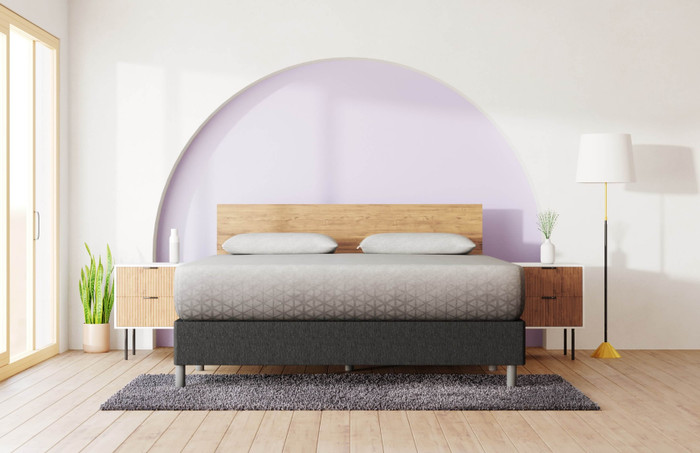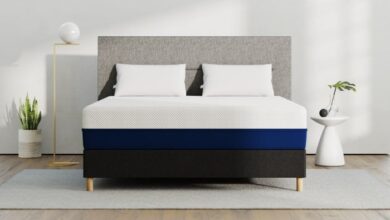How to Tell How Old Your Mattress Is?

November 4th, 2025 . 9 mins read
Key Takeaways
- Every mattress has a shelf life (≈7–10 years; latex ≈12–15): materials break down → sagging/uneven support → more tossing, soreness, and worse sleep.
- Know the age & condition: check the law tag/warranty or purchase records; look for dips, lumps, allergy flare-ups, and whether you sleep better elsewhere—clear signs it’s time to replace.
- Replace when support fades; extend life meanwhile: consider durable picks (natural latex, quality hybrids), and use protectors, rotate regularly, and keep a solid base to maintain comfort and hygiene.
Your mattress is one of the most important factors in how well you sleep, yet many people overlook its age. No matter how premium or expensive, every mattress has a limited lifespan.
Over time, the materials inside—whether foam, springs, or latex—gradually break down, causing sagging, uneven support, and discomfort.
An older mattress can leave you waking up sore, tossing and turning through the night, or relying on other beds to get better rest. If you can’t remember when you last bought your mattress, or if you’re noticing changes in your sleep quality, it may be time to evaluate its age and condition.
How to Tell How Old Your Mattress Is?
If you’re unsure when you purchased your bed, there are several practical ways to determine its age.
Knowing your mattress’s age is important because even the most durable beds eventually lose support, leading to poor sleep and body aches.
1. Check the Manufacturer’s Tag
Most mattresses come with a label tag or manufacturer’s label, typically stitched on the side or foot of the mattress. This tag is more than just a piece of fabric—it carries crucial information about your bed.
You’ll often find the manufacture date (month and year of production), the brand and model number, and sometimes even safety certifications that confirm the mattress meets certain standards.
If your mattress still has this tag intact, you can immediately verify its production date and calculate exactly how long you’ve been using it. Keep in mind that the manufacture date might differ slightly from the purchase date, but it still gives you a reliable baseline for your mattress’s true age.
2. Review Purchase Records
If the law tag has been removed or is unreadable, your purchase records can come to the rescue. Start by checking your email receipts from the retailer, which usually include the date of purchase and the mattress model.
If you paid with a credit or debit card, reviewing bank or credit card statements around the time you suspect you made the purchase can also help you track down the exact date.
For online orders, most retailers maintain a purchase history on your account dashboard, making it easy to look up old orders. Even if you don’t remember the exact day, narrowing it down to the month or year can give you a good idea of how old your mattress really is.
3. Assess Signs of Wear and Tear
Even without tags or receipts, your mattress itself tells a story. Over time, natural wear and tear show clear signs that the bed has aged. Look for visible sagging, such as dips in the middle or on the edges, where you sleep most often.
If you notice lumps or uneven surfaces, it could mean the foam layers have broken down or the springs are no longer providing even support. The fabric cover may also wear out, showing fraying edges, thinning material, or even small tears.
Perhaps the most important clue is how your body feels: if you’re waking up with stiffness, shoulder pain, or hip aches, your mattress may be too worn out to keep your spine aligned.
These symptoms often indicate that your mattress is nearing or has passed its recommended lifespan, typically 7–10 years, depending on the material.
4. Track Your Sleep Quality
Sometimes, the best indicator of mattress age is how you sleep. Even if your mattress looks fine on the outside, your body can reveal whether it’s still performing well.
If you notice restless nights, frequent tossing and turning, or waking up more tired than refreshed, your mattress might no longer provide adequate comfort and support.
Allergy flare-ups are another sign—older mattresses tend to accumulate dust mites, sweat, and allergens that impact your breathing and overall health. Another telling clue is when you sleep better on hotel beds, guest mattresses, or even your couch than you do at home.
If that’s the case, it’s a strong signal your mattress is past its prime and may need replacing, no matter its official age.
5. Check the Warranty Information
Most mattress brands provide a warranty card or online warranty registration that clearly states the coverage period and the start date. Warranties usually last 7 to 25 years, depending on the brand and mattress type.
By checking the warranty terms, you can figure out when the coverage began, which will tell you roughly when the mattress was purchased.
Even if you don’t have the paper copy, many companies let you look up warranty details online with your mattress model or order number.
This is especially helpful for premium mattresses where the warranty period often aligns closely with the expected lifespan of the bed.
6. Look at the Foundation or Bed Frame
Your bed foundation or base can also give you clues about the age of your mattress. If you purchased the foundation or bed frame at the same time as the mattress, you can usually track the approximate purchase year through its receipts or labels.
For instance, adjustable bases and box springs often have their own tags or order histories. Since people tend to buy both together, finding the foundation’s age can help you estimate when the mattress was bought.
7. Recall Major Life Events
If receipts and tags are nowhere to be found, try connecting the mattress purchase to major milestones in your life. Did you buy it when you moved into a new home, got married, or started a new job?
Many people remember their mattress timeline based on big events rather than exact purchase dates. Even narrowing it down to a two- or three-year window helps you know whether your mattress is approaching the replacement mark.
8. Ask the Retailer or Manufacturer
If you remember where you purchased your mattress, you can reach out directly to the retailer or manufacturer. Many companies keep customer records, especially if you provided your name, phone number, or email at the time of purchase.
With just a few details—like your address or product name—they may be able to pull up your order history. This method is particularly useful if you bought from a specialty store or ordered online, since digital records are often kept for years.
The 2 Best Durable Mattresses for Long-Lasting Comfort
Once you know your mattress is past its prime, the next step is finding a replacement that lasts. Not all beds are built equally—some start sagging in just a few years, while others are designed for long-term durability. If you’re looking for mattresses that can truly stand the test of time, here are two of the best options:
1. Latex Mattresses
Natural latex mattresses are considered one of the most durable sleep surfaces available today. Unlike traditional foams that break down faster, latex is dense, resilient, and naturally resistant to sagging.
Many high-quality latex beds last 12–15 years or more with proper care—almost double the average lifespan of memory foam or innerspring models. Latex also resists dust mites and mold, making it a healthier choice for long-term use.
The material offers a balance of cushioning comfort and firm support, which helps keep your spine aligned over the years. For sleepers who value durability, breathability, and eco-friendliness, latex is one of the best investments.
2. Hybrid Mattresses
Hybrid mattresses combine the strength of innerspring coils with the comfort of foam or latex layers, giving sleepers the best of both worlds. The coil support system prevents sagging and provides long-lasting stability, while the top comfort layers adapt to your body for pressure relief.
High-quality hybrids typically last 8–12 years, thanks to their reinforced edges and durable coil bases. They’re especially popular among couples and heavier sleepers since they handle weight distribution better than all-foam beds.
With modern designs, hybrids also offer excellent airflow and motion isolation, making them both practical and long-lasting.
Why Mattress Age Matters for Your Sleep Health?
A mattress is more than just a place to sleep—it plays a direct role in how well your body rests and recovers each night. But no mattress is built to last forever.
Over time, materials such as memory foam, latex, and innerspring coils naturally break down, losing the firmness, bounce, and resilience they once had.
When this happens, the bed may feel less supportive and comfortable, which can gradually affect your health and overall well-being. Here’s why an aging mattress can become a problem:
Spinal Misalignment
One of the biggest risks of sleeping on an old mattress is poor spinal alignment. As foams soften and coils weaken over time, the mattress loses its ability to keep your body properly supported.
Instead of lying in a neutral position, your spine may dip or curve unnaturally, leading to poor posture during sleep.
Over weeks and months, this misalignment can cause chronic back pain, neck stiffness, and hip discomfort, making it harder to stay comfortable through the night.
Allergen Buildup
Another hidden danger of aging mattresses is the buildup of allergens. Dust mites, dead skin cells, body oils, and even mold can accumulate in the layers of an older bed.
These contaminants may not be visible, but they can trigger allergic reactions, sneezing, congestion, and even worsen asthma or skin conditions like eczema.
If your symptoms flare up more at night or in the morning, it may be your mattress showing its age rather than seasonal allergies.
Reduced Sleep Quality
As mattresses age, they often begin to sag or develop uneven spots. These changes might feel subtle at first, but they disrupt your body’s ability to fully relax.
You may start tossing and turning more frequently, waking up in the middle of the night, or feeling less rested in the morning despite getting a full night’s sleep.
A mattress that no longer provides consistent comfort interrupts deep, restorative sleep, leaving you drained during the day.
Body Aches and Stiffness
Worn-out materials also mean reduced cushioning for pressure points such as your shoulders, hips, and lower back. Without this protective layer, your body absorbs more stress from the uneven surface, causing you to wake up sore or stiff.
Over time, these aches can become a daily struggle, even if you are otherwise healthy. Many sleepers don’t realize that their morning discomfort is directly linked to the age of their mattress rather than lifestyle factors.
Average Mattress Lifespan
Most mattresses last between seven and ten years, but this timeline varies depending on the materials, construction, and care. A high-quality latex mattress, for example, can often last twelve to fifteen years, while budget innerspring beds may wear out in less than seven.
Rotating your mattress regularly and using a proper base can help extend its life, but eventually, all mattresses lose their ability to provide proper support. Knowing when your mattress is nearing the end of its lifespan is key to protecting your sleep health.
When Should You Replace Your Mattress?
Even the best mattress won’t last forever. While some models—like natural latex—are designed to outlast others, most beds eventually lose their comfort and support over time. A worn-out mattress can quietly affect your sleep quality, posture, and even long-term health.
- It’s older than 8–10 years (or 12+ for latex): Most mattresses, whether memory foam, innerspring, or hybrid, have a lifespan of around 8–10 years. Latex mattresses can stretch up to 12–15 years with proper care. If your bed has crossed this timeline, it’s likely past its peak performance.
- You wake up with aches and stiffness: A mattress that no longer supports your body properly can cause back pain, hip discomfort, or morning stiffness. If your sleep feels less restorative and you wake up sore, it’s a clear indicator that your mattress has worn down.
- The mattress is sagging or lumpy: Visible dips, sagging in the middle, or lumps that you can feel through the surface are strong signs the internal structure—whether foam or coils—has broken down. Once this happens, comfort and support are compromised.
- You sleep better on other beds: If you notice that you wake up more refreshed after sleeping on a hotel bed, a guest room mattress, or even your couch, it means your own mattress is no longer providing the rest your body needs.
- Allergies worsen when you’re in bed: Over time, mattresses collect dust mites, sweat, and allergens. If you experience frequent sneezing, congestion, or skin irritation while in bed, your old mattress could be a major trigger.
How to Extend the Life of Your Mattress?
Buying a mattress is a big investment, and the way you care for it can add years to its lifespan. Here are simple but effective ways to keep your mattress in top condition:
- Use a mattress protector: Shields your bed from spills, sweat, dust, and allergens, keeping the layers clean and intact.
- Rotate regularly: Turn the mattress head-to-foot every few months to prevent uneven sagging and body impressions.
- Keep it on a supportive base: A strong platform, box spring, or adjustable base prevents the mattress from dipping or losing shape.
- Clean and air it out: Vacuum the surface and let it breathe occasionally in fresh air and sunlight to reduce bacteria and odors.
- Avoid rough use: Don’t let kids jump on the bed or place heavy objects on it, as this can damage springs and foams.
- Maintain a healthy sleep environment: Keep your room cool, ventilated, and humidity-controlled to prevent mold, mildew, and material breakdown.
FAQs
How can I tell when my mattress was made?
The easiest way to check your mattress’s age is by looking at the manufacturer’s law tag, which is usually sewn into the side or foot of the bed. This tag typically includes the exact month and year of manufacture, along with the model number. If the tag is missing, you can also check your purchase receipts or order history from the retailer.
Can a mattress last 20 years?
While it’s rare, some high-quality latex mattresses can last close to 20 years with excellent care. However, most mattresses—whether memory foam, hybrid, or innerspring—should be replaced within 8 to 12 years.
Even if a mattress appears intact, the support layers often lose their resilience over time, leading to subtle dips, poor spinal alignment, and reduced sleep quality.
Does flipping a mattress make it last longer?
Flipping or rotating your mattress can definitely help extend its usable lifespan, but it depends on the design. Double-sided mattresses are made for flipping, while most modern single-sided models should only be rotated every few months to distribute wear evenly. Always follow the care instructions for your specific mattress type to avoid damage.
What’s the average mattress lifespan?
Most mattresses last between 7 and 10 years, but this can vary widely depending on materials and construction. Latex mattresses are the most durable, lasting up to 12–15 years, while standard innerspring beds may only last 6–8 years. Hybrids typically fall in between, with an average lifespan of 8–12 years.
How do I know if my mattress is too old?
Beyond the number of years, your body often tells you when it’s time to replace your mattress. If you wake up with stiffness, back pain, or notice sagging, lumps, or visible wear on the surface, it’s a strong sign your mattress has reached the end of its life. Another clue is sleeping better in hotels or on other mattresses, which means yours is no longer providing proper support.
Do mattress protectors help extend mattress life?
Yes, using a mattress protector is one of the best ways to safeguard your bed against spills, sweat, dust mites, and allergens. By keeping the surface clean and dry, a protector helps preserve the integrity of the foam or coils inside, ultimately extending the lifespan of your mattress.
Does the type of sleeper affect mattress durability?
Absolutely. Heavier individuals or couples sharing a bed may notice sagging and wear sooner than lighter solo sleepers. Similarly, side sleepers often put more pressure on hips and shoulders, which can cause indentations in softer beds. Choosing the right mattress type for your body weight and sleep style is key to maximizing durability.
Final Thoughts
Your mattress has a bigger impact on your health, comfort, and overall well-being than most people realize. As it ages, its ability to provide proper support and comfort naturally declines, often leading to poor sleep quality, morning aches, and even long-term posture issues.
By keeping track of your mattress’s age and watching for key signs of wear, you can make an informed decision about when it’s time to replace it.
Choosing a durable, well-constructed mattress ensures not only a longer lifespan but also consistent comfort and healthier sleep for years to come. Investing in your sleep is ultimately an investment in your quality of life.
This article is for informational purposes and should not replace advice from your doctor or other medical professional.


